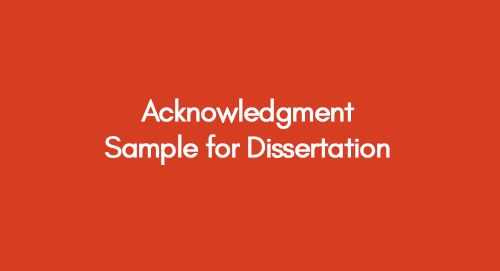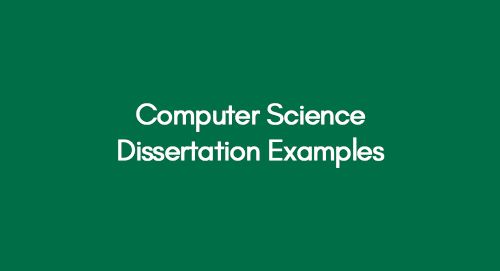
Dissertation Abstract Examples
February 14, 2023
Acknowledgment Sample for Dissertation
February 20, 2023A computer dissertation demands extensive planning and preparation because it is a difficult and demanding task. Without a well-thought-out strategy, you risk losing sight of your goals, skipping important deadlines, and delivering work that is below average.
Computer Science Dissertation Topics
In this article, we will take you through dissertations with complete formatting and structuring with the help of computed dissertation examples. From describing your journey of writing a code to how to merge it successfully into your dissertation, this guide will cover all aspects of dissertation writing.
Example: 1 Internet Censorship in UAE: Freedom of Internet
Example: 2 National Cyber Security Policy and Strategy of Ghana: A Qualitative Analysis
Basic Format for Your Computer Science Dissertation
The dissertation needs to be prepared for a technically good reader who may not be well-versed in the specific Computer Science matters at hand. Straightforward writing that is also simple to read, clear explanations with good illustrations, little to no jargon, and the proper use of mathematics all contribute to better outcomes. Planning and time are needed while writing a dissertation.
Always start working on your dissertation at least two months before submission. You won’t want to band your head around an errored or miss programmed code. So, check everything at least two weeks before to have enough time for needed changes.
- Dissertation PDF files must be A4 paper formatted.
- Typeset in 12-point type with a minimum of 2 cm margins.
- Fewer than 15 gigabytes in size, and (preferably) use embedded fonts.
The dissertation's major body, which extends from the first page of the Introduction to the last page of the conclusions, must not be more than 40 pages or include more than 12,000 words (including tables and footnotes).
You should ensure that no direct personal identifiers are included in the dissertation's main body (pages 3 and beyond) or appendices (i.e., their name or their CRSID). To have a proper understanding of the format, make sure to check out computer dissertation examples or research papers published before.
Standardized Structure of Computer Science Dissertation
- Cover page
The cover page covers your info, college or department details and the topic you are pursuing.
- Declaration of originality
Before the Proforma, all dissertations require to include an anti-plagiarism statement. The declaration has to be written in the same syntax.
[Name] of [College], being a candidate for ____ of the Computer Science, I hereby declare that the work detailed in this dissertation is all of my original work, excluding any specific exemptions that may be made below, and that it does not contain any content that has already been used extensively for a similar purpose.
Signed [signature]
Date [date]
You can either input your full name in replacement of a handwritten signature or attach a scanned copy of your signature.
- Proforma
The declaration of originality is followed immediately by the single proforma page, which serves as a prologue. Direct personal identifiers like your name or CRSID should not be included on the proforma page or any following dissertation pages. The Proforma must be set up as follows:
- Your candidate ID.
- Project's title.
- The Year and Examination.
- Dissertation’s Word count.
- The number of lines of code created by the student in the finished product of their software is known as the code line count.
- Project's founder.
- Project Manager.
- A summary of the project's initial goals, not more than 100 words.
- One hundred words maximum to summarize the work.
- Describe any particular challenges you encountered during your research process if required.
- Table of contents
The table of contents contains all the chapters and subheadings in your dissertation. A content table can be easily auto-generated in Word.
- Chapter 1: Introduction
The Introduction should include a brief overview of previous relevant work, describe the main driving force behind the research, and demonstrate how it fits into the larger field of computer science. Generally, lengthy quotes from technical papers or books shouldn't be necessary. Any lengthy quotation that requires more than a simple bibliographic reference should be placed in an appendix.
- Chapter 2: Preparation
This chapter should outline the work done before code, hardware, or theories were developed. It should demonstrate how the initial project concept was improved and clarified so that the implementation stage wouldn't involve too much trial and error.
It is crucial to show that a suitable professional strategy was used throughout this chapter and the dissertation.
This chapter will take on a variety of forms depending on the dissertation, but to emphasize the professional approach, it is likely to include a section titled "Requirements Analysis" and make reference to the proper software engineering methods employed in the dissertation. The chapter will also list any new systems and programming languages that had to be learned and any complex ideas or algorithms that needed comprehension.
Declaring the starting point is crucial. Any existing codebases or resources that your project draws on are included here. Although it may expound on it or note modifications, the material in this section is frequently the same as the text in your proposal.
- Chapter 3: Implementation
This chapter should outline what was created, such as the software created, the hardware constructed, or the theory developed. To show a professional approach was taken, any design approaches that anticipated the testing phase should be described.
High-level code snippets may be included in program descriptions, but it is typically preferable to leave substantial sections of code in appendices or skip them completely. Similar recommendations apply to circuit schematics or specific instructions in a machine-checked proof.
- Chapter 4: Evaluation
Assessors will be looking for indications of success and proof of an exhaustive and systematic review at this point. You can also add examples of output, timing tables, and images of workstation screens, oscilloscope traces, or circuit boards. It is important to maintain a professional demeanour at all times.
For example, a professional scientist would often have a poor opinion of a graph that does not include confidence intervals. Like with coding, extensive sample output examples are typically better placed in appendices or eliminated entirely.
- Chapter 5: Conclusions
The conclusion should summarize all of the main points from your paper and reiterate your thesis statement. It's also important to leave readers with something to think about so that they remember your paper long after they've finished reading it.
- Bibliography
It is customary to include a bibliography, but it is not required. The formatting needs to be accurate and consistent.
- Appendices
Although not required, it is typical to include one or more appendices. Appendices are the logical places to put such materials since assessors prefer to see some sample code or sample circuit diagrams. Therefore, relevant appendices should be included in software and hardware projects.
- Index
- Project Proposal
After the dissertation, you must attach a copy of the original project proposal.
No such specific structural framework exists for writing a PhD dissertation. Therefore, you should frame a structure aligned with the chosen research topic. Ensure your computer dissertation covers all the necessary chapters, research data, coding, and calculations.
Qualities of a Good Computer Science Dissertation
A strong computer science dissertation should have a few characteristics that show a thorough knowledge of the subject as well as strong writing and research abilities. The following qualities of a good computer dissertation are:
- Relevance: A good computer dissertation addresses a current and important issue in the field of computer science.
- Originality: It presents new and original ideas, theories, or methods that contribute to the field of computer science.
- Rigour: The dissertation is well-researched, using valid and reliable sources, and is executed with a high level of rigour and attention to detail.
- Clarity: It is well-organized and written in concise and coherent language that is easy to understand.
- Adequate coverage: Your dissertation will comprehensively cover the chosen topic, including an in-depth literature review, methodology, results, and discussion.
- Sound arguments: Presents well-supported and logically consistent arguments.
- Appropriate methodology: Uses appropriate research methods well-suited to the chosen topic and research questions.
- Critical analysis: Critically evaluates existing research and presents a balanced and objective analysis of the results.
- Proper citation: A good computer dissertation properly cites all sources used and adheres to academic standards of citation and referencing.
Conclusion
Writing a computer science dissertation can be challenging but also incredibly rewarding if done right. By following already crafted computer dissertation examples and basic guidelines, such as researching thoroughly while tracking & citing sources properly and proofreading multiple times before submission, students can craft impressive dissertations that will demonstrate their capabilities as scholars and help them stand out from their peers.
Get an Immediate Response
Discuss your custom requirements with our writers
Free Online Plagiarism Checker For Students
We will email you the report within 24 hours.
Upload your file for free plagiarism





























